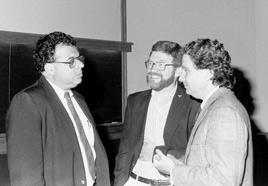1991: The Cell Cycle, Vol. LVI
Organizer: James D. Watson
The brain will be to the next century what the gene has been to the 20th century. At the start of this century, we knew that genes were on chromosomes, but what they were chemically or how they functioned was a total mystery. Now, of course, much, much more is known about the brain. This has been far from a sleepy century for brain research, and an extraordinary accumulation of anatomical data is now being complemented by experiments localizing definite tasks to specific collections of nerve cells. But compared to the gene, the brain, at least in today's ignorance, seems an infinitely more daunting objective. No one has any precise ideas about how complex perceptions are stored in our brains, much less retrieved when our memories work as we wish.
How we will reach these objectives is far from clear, except for the virtual truism that we should diversify our approaches and at least for the present not divert too many of our resources toward anyone approach. We must also see to it that the theorists learn the facts of the experimentalists and that the experimentalists also begin seriously to learn what the neural modelers are up to. It was with this objective that we decided to hold the 1990 Symposium (our 55th) on The Brain. This was to be our sixth symposium that focused on nerve cells. In 1936, we focused on Excitation Phenomena; in 1952, on The Neuron; in 1966, on Sensory Perception; in 1975, on The Synapse; and in 1983, on Molecular Neurobiology. The intervals between neurobiology-oriented meetings have steadily shortened and will likely continue to do so given the increasing number of talented young scientists who now see the brain as the ultimate challenge for biology.
In choosing the speakers, I needed much advice, and in particular, I thank Max Cowan, Francis Crick, Tom Jessell, Eric Kandel, Charles Stevens, and Terry Sejnowski. Later in organizing the final program and in selecting the order in which the symposium papers appear in these volumes, I particularly thank Eric Kandel, whose advice has been invaluable to me since the start of our neurobiology summer teaching program in 1971. The final program contained 105 presentations given over a one-week-long period before an audience that totaled 320. On opening night, there were splendid introductory talks by Shosaku Numa, Martin Raff, Sten Grillner, William Newsome, and Marcus Raichle. The summary, artfully given, was by Michael Stryker.
| 
The final result was a wonderful, although intellectu¬ally exhausting, experience that more than justified the money and time needed for its organization and execution.
Financial support for such a large meeting as the Symposium comes from many sources. We gratefully acknowledge the National Institute of Mental Health (an Institute of the Alcohol, Drug Abuse, and Mental Health Administration); the National Cancer Institute, the National Institute of Child Health and Human Development, the National Institute of Neurological Disorders and Stroke (divisions of the National Institutes of Health); the U.S. Department of Energy; and the National Science Foundation. Essential funds also came from our Corporate Sponsors: Alafi Capital Company; American Cyanamid Company; AMGen Inc.; Applied Biosystems, Inc.; Becton Dickinson and Company; Boehringer Mannheim Corporation; Bristol-Meyers Squibb Company; Ciba-Geigy Corporation/Ciba¬Geigy Limited; Diagnostic Products Corporation; E.I. du Pont de Nemours & Company; Eastman Kodak Company; Genentech, Inc.; Genetics Institute; Hoffmann-La Roche Inc.; Johnson & Johnson; Life Technologies, Inc.; Eli Lilly and Company; Millipore Corporation; Monsanto Company; Pall Corporation; Perkin-Elmer Cetus Instruments; Pfizer Inc.; Phar¬macia Inc.; Schering-Plough Corporation; The Upjohn Company; The Wellcome Research Laboratories, Burroughs Wellcome Co.; and Wyeth-Ayerst Research.
Registration and housing for the participants were organized with care and courtesy by the staff of the Meetings Office: Maureen Berejka, Barbara Ward, Karen Otto, Diane Tighe, Michela McBride, and Marge Stellabotte. Jim Hope and his staff provided admirable catering, and once again Herb Parsons and his assistants delivered a flawless audiovisual service. These books were edited by Dorothy Brown, Patricia Barker, and Ralph Battey, assisted by Joan Ebert, Mary Cozza, and Inez Sialiano, and their production was overseen by Nancy Ford.
— Peter Sherwood |